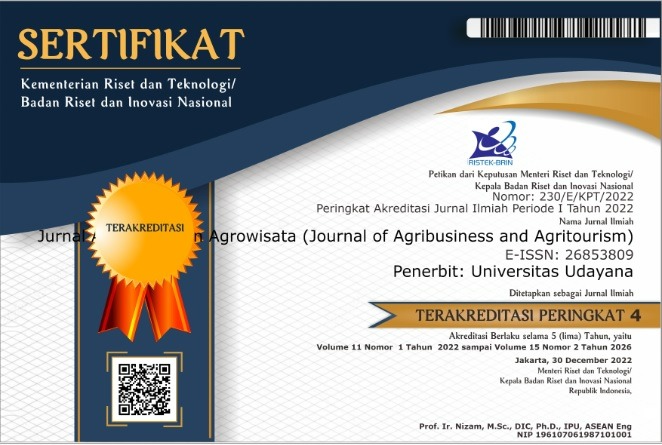Analisis Pendapatan Usahatani Padi Varietas Ciherang dengan menggunakan Sistem Tanam Legowo Jajar 2:1 (Studi Kasus di Subak Sengempel, Desa Bongkasa, Kecamatan Abiansemal, Kabupaten Badung)
Abstract
Rice Farming Revenue Analysis of Ciherang Varietyby using the PlantingSystem of Legowo Row 2:1 (A Case Study in the Subak of Sengempel, Bongkasa Village, Sub-District of Abiansemal, Badung Regency)
Rice is one of the crops that has the potential to be developed economically. The waythat can be done to increase the rice production is by the use of superior and effectiveagricultural technology. Farmers in the Subak of Sengempel are growing the ricevarieties of Ciherang by using Legowo row planting system 2:1 to boost theproduction of rice. The purpose of the study was to determine the revenue, R/C ratioand the constraints of Ciherang varieties of rice farming using Legowo row plantingsystem 2:1 in the Subak of Sengempel, Bongkasa Village, Sub-District ofAbiansemal, Badung Regency. The selection of location was conducted purposively,and the determination of the respondents was taken by purposive sampling consistingof 30 farmers of respondents. The results of research of Ciherang varieties of ricefarming by using Legowo row planting system 2:1 showed that in one growingseason, the production costs incurred was Rp 15.533.330,99/hectare, obtaining Rp27.109.333,33/hectare, which generated revenues of Rp 11.576.002,34/hectare. TheR/C ratio was 1,75 per hectare and theobstacles facedwere technical problems in ricecultivation of Ciherang varieties. Farmers are advised to make the cultivation of ricevarieties of Ciherang using Legowo row planting system 2:1 because the ricefarming is profitable or feasible.The farmers should suppress or reduce theproduction costs, especially the labor costs outside of the household. The farmers areexpected to anticipate the pest attack in rice plants.







